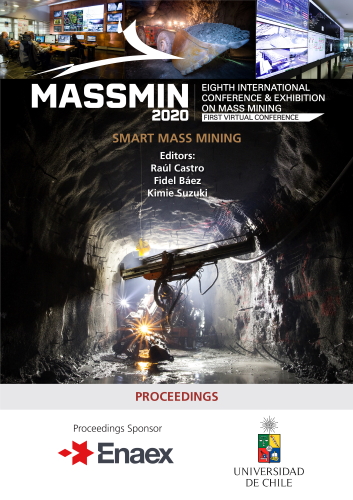Back analysis of the effect of hydraulic fracturing preconditioning on mining-induced seismicity at the main access of New Mine Level project, CODELCO Chile - El Teniente Division

|
Authors: Ghazvinian, E; Damjanac, B; Lorig, L; Cavieres, P; Madrid, A |
This paper is hosted with the kind permission of Lulea University of Technology, International Conference & Exhibition on Mass Mining, 2024.
DOI https://doi.org/10.36487/ACG_repo/2063_13
Cite As:
Ghazvinian, E, Damjanac, B, Lorig, L, Cavieres, P & Madrid, A 2020, 'Back analysis of the effect of hydraulic fracturing preconditioning on mining-induced seismicity at the main access of New Mine Level project, CODELCO Chile - El Teniente Division', in R Castro, F Báez & K Suzuki (eds), MassMin 2020: Proceedings of the Eighth International Conference & Exhibition on Mass Mining, University of Chile, Santiago, pp. 249-263, https://doi.org/10.36487/ACG_repo/2063_13
Abstract:
CODELCO has been using hydraulic fracturing (HF) to precondition rock masses at El Teniente Mine. There are indications that HF preconditioning is effective in controlling mining-induced seismicity around the current infrastructure and may also provide other mining benefits (e.g., caveability) elsewhere. The initial excavation of Túnel Acceso Personal (TAP) to the New Mine Level experienced frequent and relatively strong seismic activity. To reduce the seismic hazard during continued TAP excavation, the mine carried out HF preconditioning of the rock mass along the projected tunnel alignment before tunnel advance. Reduced maximum seismic event magnitude was observed for the preconditioned rock mass during tunnel advance when compared to un-preconditioned rock. This paper discusses the use of a distinct element numerical modeling code, 3DEC, to analyze the HF preconditioning trial and numerically demonstrate the effect of HF preconditioning on the reduction of mining-induced seismic hazard. In particular, it addresses the calibration process to numerically reproduce the seismic catalog associated with HF preconditioning and tunnel advance in the preconditioned rock mass. Subsequently, the model was used to compare mining-induced seismicity in the preconditioned and un-preconditioned rock masses. Back analysis of this experiment by means of coupled hydro-mechanical models provided further insight into the mechanics of HF preconditioning and its use as a tool for reducing and controlling mining-induced seismicity. One mechanism that can cause seismicity during HF and reduce the potential for subsequent mining-induced seismicity is the interaction between the hydraulic fracture and the discrete fracture network (DFN), resulting in “hydro-shearing” on pre-existing fractures caused by fluid leakoff from the main hydraulic fracture. The importance of hydro-shearing in successful application of HF treatment in reducing the mining-induced seismic hazard during the TAP advance is discussed based on observations from the calibrated numerical model.
References:
Blanksma, D, Damjanac, B & Lorig, L 2018, ‘Effect of Hydraulic Fracturing Preconditioning on Mining-Induced Seismicity at Túnel Acceso Personal – Proof-of-Concept Study’, Itasca report ICG 2-182607 to CODELCO.
Brzovic, A, Skarmeta, J, Blanco, B, Dunlop, R & Sepulveda, M 2017, ‘Sub-horizontal faulting mechanism for large rockbursts at the El Teniente Mine,’ in Proceedings, 9th International Symposium on Rockbursts and Seismicity in Mines, (November 2017, Santiago).
Ghazvinian, E, Damjanac, B & Lorig L 2019, ‘Back-Analysis and Model Calibration of Hydraulic Fracturing Preconditioning at Túnel Acceso Personal’, Itasca report ICG 2-1826-08:19R23 to CODELCO.
Itasca Consulting Group, Inc. 2016, ‘UDEC — Universal Distinct Element Code. Minneapolis: Itasca’.
Itasca Consulting Group, Inc. 2015, ‘3DEC – Three-dimensional Distinct Element Code, Ver. 5.2. Minneapolis: Itasca’.
McGarr, A 1999, ‘On relating apparent stress to the stress causing earthquake fault slip,’ Journal of Geophysical Research: Solid Earth, vol. 104, pp. 3003-3011.
Morales, RF, Henriquez, JO, Molina, RE, Araneda, OA & Rojas, EG 2007, ‘Rock Preconditioning Application in Virgin Caving Condition in a Panel Caving Mine CODELCO Chile El Teniente Division,’ in Proceedings, Deep Mining 2007 (Fourth International Seminar on Deep and High Stress Mining, November 2007, Perth) pp. 111-120, Y. Potvyn, Ed. Perth: Australian Centre for Geomechanics.
Schmidt, ES & Eberhardt, E 2017, ‘Numerical investigation of the use of hydraulic stimulation to mitigate fault slip risk in deep mines,’ in Proceedings, Deep Mining 2017 (Eighth International Conference on Deep and High Stress Mining, March 2017, Perth) pp. 79–88, J. Wesseloo, Ed. Perth: Australian Centre for Geomechanics.
Verzani, LP, Russo, G, Grasso, P & Cabañas, A 2015, ‘The Risk Analysis Applied to Deep Tunnels Design—El Teniente New Mine Level Access Tunnels, Chile,’ In Engineering Geology for Society and Territory, vol. 6, pp. 1023-1030.
© Copyright 2025, Australian Centre for Geomechanics (ACG), The University of Western Australia. All rights reserved.
View copyright/legal information
Please direct any queries or error reports to repository-acg@uwa.edu.au
View copyright/legal information
Please direct any queries or error reports to repository-acg@uwa.edu.au
